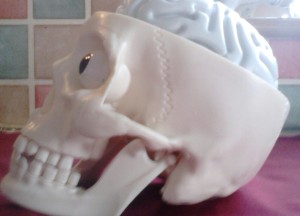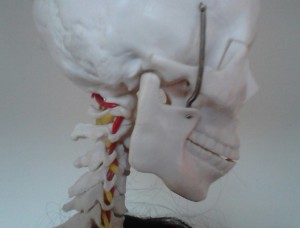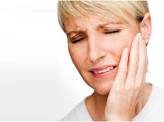Often, I hear people say ‘I have terrible TMJ’. I am tempted to respond ‘Actually you have two’. TMJ stands for tempero-mandibular joint, which is just the name of the structure, not the problem. You (hopefully) have two of them, one in front of each ear – it’s where your jaw (or mandible) is attached to your skull (the temporal part of the equation)
Facial pain and/or headaches can often be the result of problems with these two small but powerful joints. To find your TMJ’s, put your fingers on your cheekbones and follow them back towards your ears. Come down about 1/2 and inch and gently open and close your mouth and you should feel your TMJ’s moving. How do they feel? Any pain? Any crunchy noises? Does one move before the other? Is there any clicking?
Now from their resting position over your TMJ’s, gently move your index fingers under your ear lobe and up and behind your ear to the base of your skull – this is actually where your spine begins. So if you have a problem with your TMJ’s, your spine can’t help but be affected and vice versa. In my experience, a lot of people who may have been told they have migraines actually have problems in the TMJ’s and upper spine
Symptoms of tempero-mandibular problems may include pain around the ears, possibly spreading to the neck, shoulders, head or face. There may be tenderness in the muscles in the face, tinnitus (ringing in the ears), dizziness, difficulty eating, especially biting or chewing as well as decreased opening of your mouth and difficulty with moving your neck.
The tempero-mandibular joint is one of the smallest and most intricate in the body – it needs to be treated with respect and kindness (don’t we all!). To open our mouths, our TMJ’s have to rotate and slide at the same time. If they don’t work properly, we can’t eat, speak, smile or laugh without pain. When we are stressed, we clench our teeth together, compressing our jaws. When we ‘bite our tongues’, holding back from saying what we really want to say, we carry all that tension in our facial muscles. Is it a coincidence that women are affected four times as much as men? We also have to remember that the TMJ has a number of oestrogen receptors, so our hormones, as always, have a role to play.
So, when is it TMJ dysfunction, and what can we do about it?
Because TMJ problems can cause pain both locally but also refer pain to the head, neck and face, diagnosis is important. There is also the delightful possibility of having migraines and problems with your TMJ at the same time….
Have you noticed that your teeth don’t fit together like they used to? Do the muscles in your face, jaw or neck feel tender or stiff? Can you reproduce your pain by gently pressing on the muscles around your cheeks, jaws or upper neck? Does biting into an apple or chewing a piece of steak irritate your pain? Is your pain affected by stress? By your menstrual cycle? By the food you eat? Try keeping a symptom diary for a month where you track any head/neck/face pain along the days of your menstrual cycle (the first day you get your period is Day 1), along with the food you eat each day. Don’t forget to factor in other considerations such as – when was your last dental check? Your last eye test? When did you last have a bra fitting – our breasts change shape and size as we go through life. adequate support makes maintaining good posture easier. Do you always carry your handbag on the same side? How heavy is it – really?! Do you need everything in there – really?!
In my next post, I will go through some simple postural techniques and a simple exercise programme to promote TMJ health – as always if you have concerns, please consult your healthcare professional.
Until next time…..






Absolutely! That would be great! Mx
LikeLike